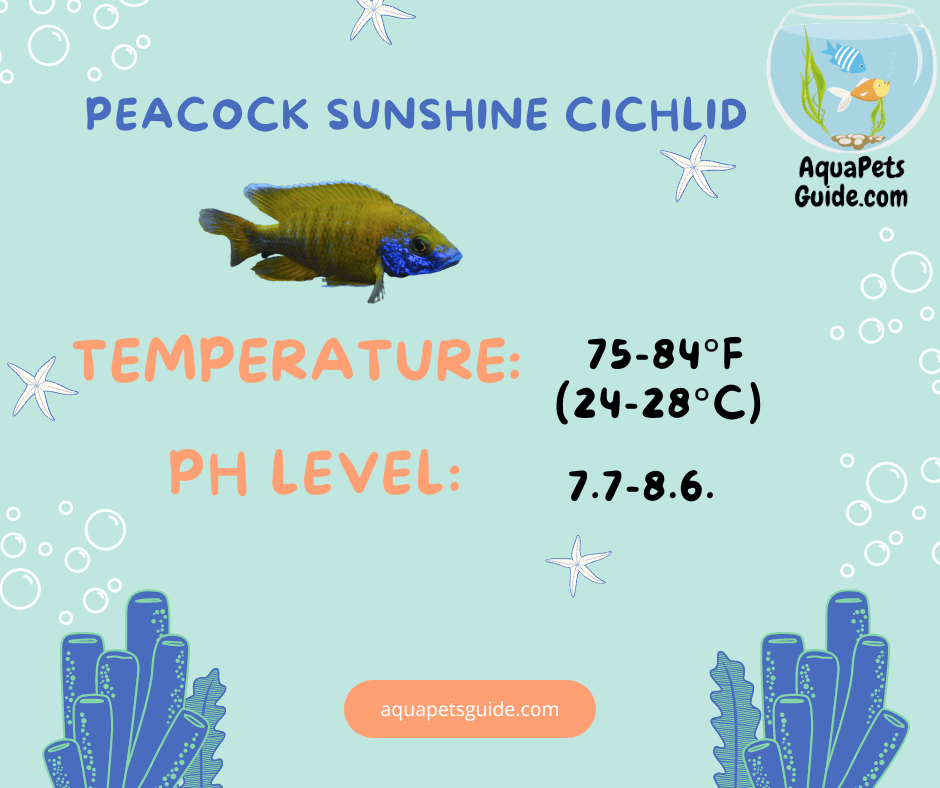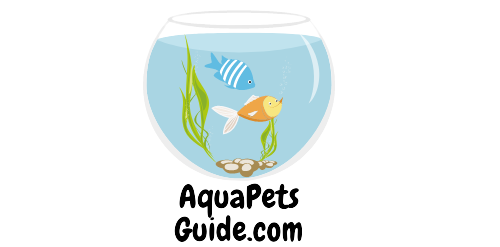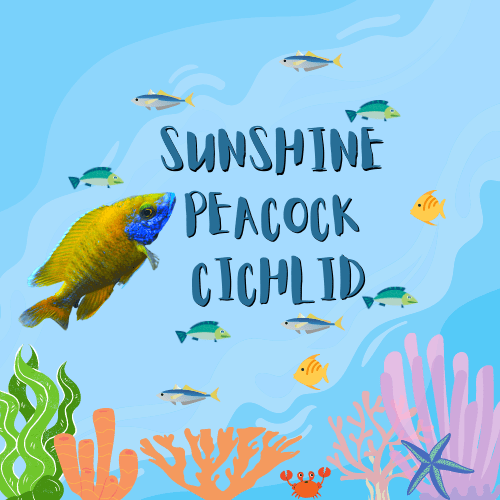Exquisite blue face and a yellow body – that’s the typical appearance of the Sunshine Peacock Cichlid.
While they come in other color variations, the one known as Sunshine Peacock (Aulonocara sp. Stuartgranti Maleri) is characterized by a completely blue face and a yellow body.
Now after countless breeding and cross-breeding, we can see variations with light blue faces or only a little blue in them with the blue color covering and expanding to their bodies. (Yeah so much blue)
The color generally depends on how they were bred on farms today. If the breeding process was handled carefully by pairing a male with a clear blue face, there is a high chance that the offspring are gonna look the same.
Females Sunshine Peackok looks less colorful and don’t have the same appearance as the males, so you won’t know if they have any effect on getting the coloration for the offspring. You might want to know this if you are planning on breeding them.
And while coloration is something we desire to see, The Sunshine Peacock Cichlid is more than that!
They are a unique and kinda aggressive type of fish. Your guests might be fascinated seeing it in your aquarium.
Let’s dive right in and learn more about some of the amazing features and care requirements of this Cichlid specie.
Sunshine Peacock Cichlid characteristics
Appearance:
So by now you already know that males have clear blue faces with yellow bodies, and females have less colorful bodies.
But did you know that they can change their colors? That’s right, their color can change depending on their mood or when it’s breeding season.
And, as I mentioned earlier, while color is important, the features and behavior of this fish that we are going to discover are what make it even more likable.
Lifespan
Farm-bred Sunshine Peacock Cichlids can live 7 years on average if they are cared for properly. However, there are many other conditions that can affect their lifespan, so an accurate number can be hard to pinpoint, as different people will report different numbers, It ultimately depends on the fish you have.
Size
In their adult form, males can reach 6 inches (15cm) while females are generally shorter by 2 inches.
Habitat and Tank requirement
Habitat
Before we dive into the care requirement, let’s know more about their natural habitat which will help you understand what kind of environment they like to stay in.
The Sunshine Peacock Cichlid belongs to the African continent and can be found especially in Lake Nyasa which is one of the biggest lakes in the world with more than 700 types of Cichlids native to this lake. A cichlid haven!
This lake and the area around it are known for being rocky and dry. The water surface is clean and you can see 64 feet (20m) down but this visibility decreases when it rains and the waters become muddy.
So when considering building a tank for them, maintaining clean water quality with good parameters and adding rocks should be considered.
Tank size
You should consider a 60-gallon aquarium if you plan on getting one Sunshine Peacock, and work on adding at least 10 more gallons for every peacock you plan to add. The Sunshine Peacock Cichlid is territorial and likes to protect its own territory.
You can pair it with the same species without any issue, you just have to watch for territorial disputes and provide plenty of hiding places like rocks and wood.
Temperament:
There is a general outline that we can refer to when classifying aggressive fish from peaceful fish. In our case, the Sunshine Peacock Cichlid can be classified as a semi-aggressive fish.
They are territorial and will not lay low if any other fish invade their territory. They could get into some serious fights. So its better to get more females to divert their aggression away if you have multiple of them at once.
Care Requirements:
Water Requirement
Lake Nyasa’s water condition is typically alkaline with a pH between 7.7-8.6, and the water tends to be warm all the time with a surface temperature ranging from 75°F to 84°F, while deep water temperature tends to be around 72 °F.
So the recommended parameters are as follows:

Maintaining water quality
To maintain good water quality be sure to use your test kit to measure ammonia, nitrite, and nitrate level in the tank regularly and perform water changes when necessary.
You should also be aware of not overfeeding them as that can lead to the fish producing more waste which will dilute the water and raise the ammonia and nitrate level.
Tip 1: Remove any leftover food that they haven’t consumed to avoid high levels of nitrate.
Tip 2: You can subscribe to our newsletter to get my Weekly Planner for the feeding and water change schedule.
Feeding and Diet requirements
A balanced diet isn’t only helpful for us humans, fish might need more care and diversity in their diet than us. A healthy diet can help your fish stay healthy and your water stays clean.
In its natural habitat, the Sunshine Peacock Cichlid is known for eating insect that floats on the water’s surface and crustaceans that are available in almost any lake around the world and the favorite food of omnivores fish.
For a diverse diet, you could give them plant-based food and high-quality pellets and flakes in addition to meaty food whether frozen or live food.
You can also add food that is rich in minerals and is specially manufactured for cichlids. This can help in growth and coloration.
Common health issues and how to prevent them
I’ve talked before about different diseases that can affect fish in an aquarium like the Candy Cane Coral health issues and the Picasso clownfish potential diseases and ways to prevent them, and although they are saltwater fish the method of prevention is still the same as you can see from the freshwater Green pleco disease prevention methods.
To prevent diseases such as ich and fin rot, water quality is important and we’ve talked above about how to maintain the optimal water environment that is free from diseases.
You should also watch for any abnormal behaviors that your Sunshine Peacock could exhibit, such as a sudden change in behavior or when it started to get distressed. This could indicate that it’s suffering from stress or from an infection.
Breeding
If you are a beginner, you may want to establish a breeding tank first before deciding how to breed them, and here are some tips to help you get started breeding them and caring for the fry.
Breeding environment:
– To get started with the breeding you might want to first isolate the male and the female in a separate tank and provide them with high-protein food that will condition them into breeding.
– After laying the eggs the male will fertilize them and the female will stay brooding over them for about three weeks until they hatch.
– After the fries are born move the parent to another tank or move the fry to another tank and provide high-protein food for them.
Conclusion:
There are many popular Cichlids in the hobby, and there are many people who have Cichlids only tank(i know a few), but the Sunshine Peacock Cichlids doesn’t seem popular that much given that it’s rare, as you can’t normally go to your local store and see it sitting there in an aquarium. People who usually get them are those who have already prior knowledge about them.
It’s definitely a fascinating fish you could have, so if you encounter one don’t hesitate to grab it if you got the right environment.
If you already got a Sunshine Peacock, or have experience keeping them, we would love to hear about your experience in the comments below.
Happy fish keeping!

